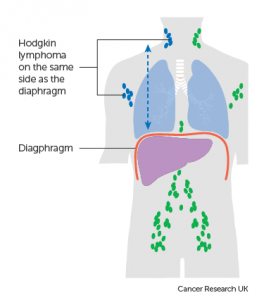“Family and friends can be great sources of support but truth be told, no one can ever really know what you are going through other than those who have been there themselves….” ~Rachele Chaar Ghosn
For Rachele Chaar Ghosn, a 24-year-old woman with Hodgkin’s Lymphoma, finding others going through treatment for Hodgkins was paramount. “After my first diagnosis and treatment plan was set, I hit the Internet hard looking for online support groups…and blogs written by other Hodgkin Lymphoma patients who are going through/have gone through what I was going through. I was comforted by the fact that I was not alone in everything I was experiencing, both physically and emotionally and it gave my otherwise abnormal situation a sense of normalcy,” she wrote.
When she relapsed 3 months after the end of her first treatment, she started a blog for people going through refractory Hodgkin’s Lymphoma, called My Second Fight With Hodgkin’s Lymphoma. She is currently in treatment and has agreed to write a guest post for Medivizor during this second set of treatments. While we await her post, we wanted to introduce her blog as a resource, provide a brief introduction to Hodgkin’s Lymphoma and give you an opportunity to sign up for more information.
What is Hodgkins Lymphoma?
Hodgkins Lymphoma is a cancer that affects the lymphatic system.
Lymphatic system
There are two systems of vessels in the body, your blood vessels and your lymph vessels. Lymph vessels  are part of the lymphatic system. One of its purposes is to drain fluids from tissues and transport that fluid to the lymph nodes. A second is to carry lymphocytes throughout your body. As such, your lymphatic system is crucial to your immune system.
are part of the lymphatic system. One of its purposes is to drain fluids from tissues and transport that fluid to the lymph nodes. A second is to carry lymphocytes throughout your body. As such, your lymphatic system is crucial to your immune system.
The organs associated with the lymphatic system are the spleen, thymus, lymph nodes and bones (specifically bone marrow). The spleen, thymus and bone marrow are involved with production and storage of immune cells: lymphocytes and granulocytes.
Lymph nodes filter the lymph, killing bacteria. Ultimately, clean lymph fluid flows to the superior vena cava and into the blood stream.
For a more detailed description of the immune system, please read Oncology Basics 2016: The Immune System and Immunotherapy.
Hodgkin’s lymphoma
As this chart reveals, there are 3 types of lymphocytes, B-cell, T-cell and Natural Killer cell. Hodgkins lymphoma is a cancer of the B-cells, although very infrequently T-cells are involved. Reed-Sternberg cells are essential to the diagnosis of Hodgkin’s lymphoma. They are mutated B-cells.

Staging of Hodgkin’s Lymphoma
These diagrams, courtesy of Cancer Research UK, show the staging for Hodgkin’s Lymphoma.
To be diagnosed Stage 1, the cancer is found in one lymph node area. For Stage II, the cancer is found in 2 or more node groups on the same side of the diaphragm.
A Stage III diagnosis means that cancer is found on both sides of the diaphragm. Finally, a Stage IV diagnosis means that the cancer has spread beyond the lymphatic system to other organs like the liver, lungs or bone marrow.
There is another part of the staging A, B, E and X. If you are classified as A, you have not experienced weight loss, fever or night sweats. With B classification, you have experienced these symptoms. E classification refers to the cancer found in other organs near the lymphatic system and X means that bulky masses of cancer cells are present.
Your staging impacts the treatments you receive. Rachele was diagnosed Stage 2A Classical Nodular Sclerosing Hodgkin’s Lymphoma.
Knowledge is Power
For Rachele, knowledge has been important in dealing with her diagnosis. In her post Preparing For Chemo, she wrote,
“I recommend anyone going through treatment to get all the information needed from their oncologist and then to do their own reading at home. In fact, if you know what your treatment plan is then go ahead and do your homework before you see your oncologist. When I was diagnosed the first time, I read up a lot on my treatment plan, side effects etc. before going to see the oncologist for the first time. Doing so helped me organise my thoughts and feel more prepared, thus diminishing fear of the unknown; but most importantly it became so much easier to follow all the information being presented to me during my first onco visit and asking important questions that I would otherwise have not been able to formulate had I been hearing all this new information for the first time.”
Sign up for Medivizor
Luckily the Internet is available to learn about Hodgkins, but often it is exhausting and overwhelming to look for and find easy to understand information and cutting edge treatment options. Medivizor takes the work out of this search by sending to your email, personalized information and updates.
If you or someone you love is facing Hodgkins Lymphoma, Medivizor is available to help. Please sign up today.











The best information articles that you shared to us. I am very impressed with your site and also very satisfied with your suggestions they amazing. You made a good site it’s very interesting one